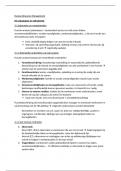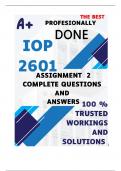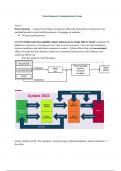Governance & Digitalization
Week 1: Introduction: How did we get here?
Digitalisation: a digital transformation that “includes a number of interconnected and evolving
technologies” (OECD). Everything is transformed into code, as opposed to analog technology. This
makes digital information very versatile. That is why digital is so powerful. Social process.
Governance: a change in the role of the state from intervention and control to steering and
coordination (Bevir, 2010). Governance is being done in a collaborative way, because with the issues
being very complex, multiple actors are needed to be involved.
difference with government: government is just one actor in the entire governance (to rule, to make
rules, to implement those rules) process (society, business, et cetera). The governance process is an
collaborative process, with a lot of actors involved.
The sustainability challenge in the future for the government is massive, because digitalisation
increases every year.
Digitalisation also comes with a lot of benefits. For example: Automated consensus formation
(Taiwan), Blockchain land registry (Honduras), Self-driving bus (The Netherlands), Voting online
(Estonia).
The impact of digital technology on governance
These challenges digitalisation bring can be divided into internal (affect ‘government’) and external
(affect the environment of the government).
- Internal view of impacts: Darrel West
As technologies involve, so do government organizations evolve in providing these new
technologies:
1. Billboard phase (static information, websites and email).
2. Partial service delivery (a bit more interactive, websites offer a little more (basic)
transactional services; pay parking, buy library card, etc.)
3. Portal stage ( ;digital ID systems)
4. Interactive democracy (internally government organizations should move into this stage
(West). In this way citizens can express their voice and participate in democracies because of
digital services. “Lots of online services and interactive features. Accountability enhancing
features and technologies for public feedback and deliberation” (how will this actually work,
will citizens use these kind of tools? It is unclear what this stage exactly would mean. People
could also abuse this possibility (for example trolls))
West: Secular change is an example of a midlevel model
that demonstrates how constrained change can unfold.
Secular change unfolds slowly but surely over time, and
eventually leads to major changes in how organizations
function. Revolutions do not have to be quick and abrupt
for there to be widespread change.
- External view of impacts: de Donk et al. (2005)
(environment of government organizations)
Public commons: the agenda of the day, room for discussion, what
happens right now, what has priority right now.
these should have ideal features to make it work: freedom and equality
, (no one tells you what to read or watch), accessibility (access to news that matters to them easily),
independence (trust in your news sources) and pluralism (different points of view, include the voice of
minorities)
which of these aspects is being influenced/changes because of digitalisation?
Another part of the external challenge is the unaccountable tech companies. Tech companies are the
largest and most powerful companies in the world. They have also been implicated in wrong turns
during the covid pandemic: Freedom of speech versus censuring wrong information. It often seems
very arbitrary, the decision that they make. These companies are increasingly powerful, and there is
little control and transparency in their decision making.
Yuval Noah Harari: Effects of digitalisation (economical, political and media shifts)
- Artificial intelligence will increasingly displace humans: So there is a big question for
government: what will happen to the work of humans? Will there be work for humans in the
future?
- Global ecology of information (the cyber river): All of the worlds digital infrastructure (all
the information that flows in our societies) are driving a new type of ecology (just like a river,
digital infrastructure will be necessary for the ecology to run).
- The shift: national economies limited to national laws and regulations now longer work:
Countries will have to collaborate a lot more.
- Decline of the traditional left-right: currently the traditional left-right distinction, is no longer
relevant. We’ll see progressionists, conservatives, nationalists, globalists, etc. The new
political distinction: Globalists versus Nationalists.
Three problems with digitalisation:
Conclusion
• Digitalisation is constantly evolving, leading to exciting innovations in the public sector and huge
amounts of new data. But this has big impacts for governance:
• Internally, government is becoming more digitalised, integrated, and interactive
• Externally, government faces a turbulent public information commons and economic and political
changes
• There are three main challenges that result:
1. Information complexity 2. Public accountability 3. Public service quality
Week 2: Challenge 1: Information complexity
Increasing information complexity Big data
How can Big data improve governance?
Week 1: Introduction: How did we get here?
Digitalisation: a digital transformation that “includes a number of interconnected and evolving
technologies” (OECD). Everything is transformed into code, as opposed to analog technology. This
makes digital information very versatile. That is why digital is so powerful. Social process.
Governance: a change in the role of the state from intervention and control to steering and
coordination (Bevir, 2010). Governance is being done in a collaborative way, because with the issues
being very complex, multiple actors are needed to be involved.
difference with government: government is just one actor in the entire governance (to rule, to make
rules, to implement those rules) process (society, business, et cetera). The governance process is an
collaborative process, with a lot of actors involved.
The sustainability challenge in the future for the government is massive, because digitalisation
increases every year.
Digitalisation also comes with a lot of benefits. For example: Automated consensus formation
(Taiwan), Blockchain land registry (Honduras), Self-driving bus (The Netherlands), Voting online
(Estonia).
The impact of digital technology on governance
These challenges digitalisation bring can be divided into internal (affect ‘government’) and external
(affect the environment of the government).
- Internal view of impacts: Darrel West
As technologies involve, so do government organizations evolve in providing these new
technologies:
1. Billboard phase (static information, websites and email).
2. Partial service delivery (a bit more interactive, websites offer a little more (basic)
transactional services; pay parking, buy library card, etc.)
3. Portal stage ( ;digital ID systems)
4. Interactive democracy (internally government organizations should move into this stage
(West). In this way citizens can express their voice and participate in democracies because of
digital services. “Lots of online services and interactive features. Accountability enhancing
features and technologies for public feedback and deliberation” (how will this actually work,
will citizens use these kind of tools? It is unclear what this stage exactly would mean. People
could also abuse this possibility (for example trolls))
West: Secular change is an example of a midlevel model
that demonstrates how constrained change can unfold.
Secular change unfolds slowly but surely over time, and
eventually leads to major changes in how organizations
function. Revolutions do not have to be quick and abrupt
for there to be widespread change.
- External view of impacts: de Donk et al. (2005)
(environment of government organizations)
Public commons: the agenda of the day, room for discussion, what
happens right now, what has priority right now.
these should have ideal features to make it work: freedom and equality
, (no one tells you what to read or watch), accessibility (access to news that matters to them easily),
independence (trust in your news sources) and pluralism (different points of view, include the voice of
minorities)
which of these aspects is being influenced/changes because of digitalisation?
Another part of the external challenge is the unaccountable tech companies. Tech companies are the
largest and most powerful companies in the world. They have also been implicated in wrong turns
during the covid pandemic: Freedom of speech versus censuring wrong information. It often seems
very arbitrary, the decision that they make. These companies are increasingly powerful, and there is
little control and transparency in their decision making.
Yuval Noah Harari: Effects of digitalisation (economical, political and media shifts)
- Artificial intelligence will increasingly displace humans: So there is a big question for
government: what will happen to the work of humans? Will there be work for humans in the
future?
- Global ecology of information (the cyber river): All of the worlds digital infrastructure (all
the information that flows in our societies) are driving a new type of ecology (just like a river,
digital infrastructure will be necessary for the ecology to run).
- The shift: national economies limited to national laws and regulations now longer work:
Countries will have to collaborate a lot more.
- Decline of the traditional left-right: currently the traditional left-right distinction, is no longer
relevant. We’ll see progressionists, conservatives, nationalists, globalists, etc. The new
political distinction: Globalists versus Nationalists.
Three problems with digitalisation:
Conclusion
• Digitalisation is constantly evolving, leading to exciting innovations in the public sector and huge
amounts of new data. But this has big impacts for governance:
• Internally, government is becoming more digitalised, integrated, and interactive
• Externally, government faces a turbulent public information commons and economic and political
changes
• There are three main challenges that result:
1. Information complexity 2. Public accountability 3. Public service quality
Week 2: Challenge 1: Information complexity
Increasing information complexity Big data
How can Big data improve governance?










